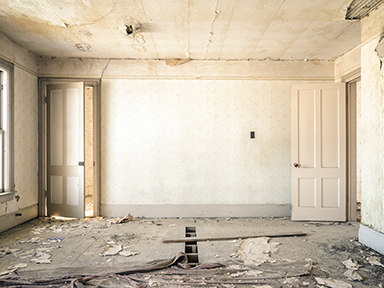What’s the difference between ‘wear and tear’ and ‘damage’? It’s a question that can be the source of frustration between landlords and tenants. We cover all the details here to help avoid confusion…
‘Fair wear and tear excepted’ is a phrase you’ll often see in residential tenancy legislation and proforma lease agreements. It usually appears under the section relating to tenants’ repair and maintenance obligations, and it often comes up at the end of the lease term.
Tenants are responsible for repairing any damage that they have caused, but they aren’t responsible for repairing or replacing worn fittings and fixtures in the rental (wear and tear) which occurs through normal occupancy of a property
The difference between wear and tear and damage is sometimes a bit of a grey area. What one person might consider to be fair wear and tear; another may think is damage. It can result in disagreements over the release of the bond – and has implications for landlord insurance claims.
Why? Because landlord insurance doesn’t provide cover for wear and tear, but it does for tenant damage (depending on the policy).
Let’s delve deeper.
Just what is ‘wear and tear’?
Although one person’s idea of what is fair wear and tear might be quite different to another’s, it’s generally considered to mean the ‘reasonable use of the property by the tenant and the ordinary operation of natural forces’. Natural forces are things like sunlight and rain.
Put simply, wear and tear is damage that naturally occurs over time in an investment property due to use and ageing. It is not caused intentionally, or by neglect, misuse or abuse.
It’s virtually impossible to live in a property without causing some form of wear & tear – worn carpet in high-traffic areas, scuff marks on walls, minor scratches on a benchtop, etc. This is wear & tear that results from the tenants’ day-to-day use of the property as a home – like walking between rooms, opening and closing doors, and using the bathrooms and kitchens.
Australia’s climate, with its scorching sun and pounding rains, will naturally take its toll on a property. Wear and tear of this nature can include things like faded curtains, carpets and floorboards, rusting gutters, cracking plaster, flaking paint or warped frames.
Who’s responsible for fixing wear and tear?
Fair wear and tear is a cost of doing business that landlords should expect. Repairing or replacing worn fittings and fixtures is the responsibility of the owner.
Unless a contract states otherwise, tenants are not responsible for paying for fair wear and tear to a property. It’s only when the tenant has been irresponsible, and accidentally or intentionally caused damage to a premises, that they are liable to pay for repairs (either directly or have the expense deducted from their bond).
If the wear and tear is unreasonable – for example, excessive wear due to the property being used for business or illicit purposes without the landlord’s consent or knowledge –then the tenant is responsible for reinstatement.
Will insurance cover the cost of wear and tear?
Wear and tear is expected and considered normal depreciation, so it’s not covered by landlord insurance. Reasonable wear is not considered to be ‘damage’ by insurers and the PDS will clearly state this is an exclusion.
What is ‘damage’ then?
When insurers talk about tenant damage, they are referring to damage that is the result of misfortune, negligence, carelessness or abuse.
Insurers generally recognise three types of tenant damage:
- Accidental – the result of sudden, unexpected or unforeseen events (for example, dropping a hot pot and scorching the laminate benchtop).
- Malicious – caused on purpose with intent to do harm, motivated by vindictiveness or spite with the aim of damaging the property (for example, kicking holes in walls).
- Intentional/deliberate – the result of an act carried out without permission but without malice, vindictiveness or spite, and with the full knowledge that the action will alter the current state of the property (for example, concreting the backyard).
Cover for these three types of damage varies between insurers. EBM RentCover provides up to $70,000 for accidental (including pet damage), intentional and malicious damage in its Premium, Ultra and ShortTerm products.
Who’s responsible for repairing damage?
Any damage caused by a tenant, their child, their pet or their guests, is the responsibility of the tenant. They have an obligation to repair or replace any damage caused.
If the damage is caused by a third party not directly connected with the tenant, or the tenant didn’t invite them onto the premises, or the event was outside of the tenant’s control (for example, break-ins, floods and traffic accidents), then the repairs are the landlord’s responsibility and may be covered by insurance (depending on the policy).
So tenant damage is covered by insurance?
If the tenant does not make good on their obligations, landlords may be able to turn to their insurance to cover the costs of repair or replacement.
While fair wear and tear is not covered by landlord insurance, accidental, intentional and malicious damage is (with EBM RentCover). With cover in place, landlords can be confident that their investment is protected if the tenant fails to make good on their damage obligations.
Avoiding disputes
Disagreements about wear and tear versus damage frequently occur between landlords and tenants, so it’s important to make sure the condition of the premises is well documented and updated at the start of the tenancy, during routine inspections and upon vacating.
Any damage to the condition of the property should be photographed/videoed and recorded. Thorough rental condition reports can not only be useful for avoiding or settling disputes over fair wear and tear, they’ll also need to be submitted as supporting documentation if the landlord needs to make a claim on their insurance for tenant damage.
*While we have taken care to ensure the information above is true and correct at the time of publication, changes in circumstances and legislation after the displayed date may impact the accuracy of this article. If you need us we are here, contact 1800 661 662 if you have any questions.
You may also like
View all
If you own or manage an investment property in a strata complex, it is important to understand who is responsible for insuring what...

Damage is damage, right? Well, not when it comes to insurance...



